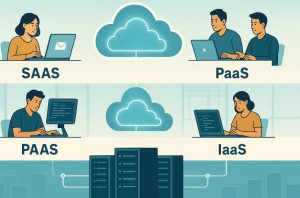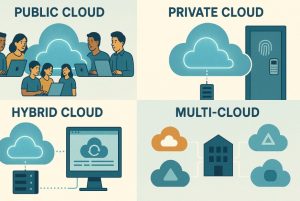
In today’s increasingly digital world, businesses, educational institutions, healthcare systems, and governments are all relying on data-driven technologies to operate efficiently.
A crucial enabler of this digital shift is cloud computing, a model that allows organisations to access and utilise computing resources like servers, storage, databases, networking, software, and analytics via the internet commonly known as “the cloud”.
Cloud computing has eliminated the need for organisations to own and maintain physical IT infrastructure. Instead of investing heavily in hardware and software upfront, they can now subscribe to services and pay only for what they use.
This flexibility is especially transformative for Indian companies, which often face constraints related to infrastructure, resources, and scaling demands.
The rapid rise in internet connectivity, smartphone usage, and government initiatives such as “Digital India” have paved the way for widespread cloud adoption across the country. It supports remote work, enables digital service delivery, and ensures business continuity in an increasingly volatile global environment.
What Are the Different Types of Cloud Computing Services?

Cloud services are typically categorised into three major models, each addressing different technological and operational requirements. These are Infrastructure as a Service (IaaS), Platform as a Service (PaaS), and Software as a Service (SaaS). They represent varying levels of control, flexibility, and management responsibilities.
What is Infrastructure as a Service (IaaS)?
IaaS provides access to essential IT resources such as virtual machines, storage, and networking infrastructure through the internet. It allows organisations to build and manage their own platforms and applications while outsourcing hardware maintenance.
IaaS is ideal for companies that want more control over their computing environment without the need to manage physical servers. It is particularly useful for businesses running complex workloads or hosting large-scale websites and applications.
| Feature | Description |
| User Control | High – full control over infrastructure |
| Maintenance | Managed by the provider |
| Ideal For | System administrators, DevOps teams |
| Common Providers | AWS EC2, Microsoft Azure, Google Cloud |
What is Platform as a Service (PaaS)?
PaaS is a cloud model that delivers a framework for developers to build, test, deploy, and maintain applications. It abstracts much of the system management, allowing developers to focus on writing code and creating functionalities.
This model is particularly valuable for organisations developing custom applications or deploying multiple projects simultaneously. It reduces the need to manage hardware or software layers and accelerates the development lifecycle.
| Feature | Description |
| User Control | Medium – focus on application development |
| Maintenance | Partially managed by provider |
| Ideal For | Software developers and tech startups |
| Common Platforms | Google App Engine, Heroku, Azure App Services |
What is Software as a Service (SaaS)?
SaaS is the most accessible form of cloud computing, offering complete software solutions delivered via the internet. Users can access these services through web browsers without any installation or configuration.
This model is ideal for end-users and businesses that want to use applications without worrying about updates, security, or underlying infrastructure. SaaS supports a range of services, including email, file storage, CRM, and office productivity tools.
| Feature | Description |
| User Control | Low – provider handles all management |
| Maintenance | Fully managed by provider |
| Ideal For | End-users, non-technical staff |
| Common Tools | Microsoft 365, Zoom, Dropbox, Salesforce |
What Are the Cloud Deployment Models?

Cloud deployment models determine how and where the computing resources are hosted and accessed. Choosing the right deployment model depends on factors such as security, compliance, scalability, and budget.
What is the Public Cloud Model?
Public cloud services are delivered over the internet by third-party providers. These services are shared among multiple users, also known as tenants, and are most suitable for workloads that require scalability and flexibility without high-security demands.
Public cloud is widely adopted by start-ups and small businesses due to its low entry cost. However, as the infrastructure is shared, security can be a concern for some organisations handling sensitive data.
What is the Private Cloud Model?
A private cloud is dedicated to a single organisation. It can be hosted on-premises or by a third-party provider. This model offers greater control, security, and customisation compared to public cloud.
Private cloud is often preferred by government institutions, banks, and large enterprises in India that require strict data governance and compliance.
What is the Hybrid Cloud Model?
Hybrid cloud combines elements of both public and private cloud environments. It enables data and applications to be shared between them, providing businesses with flexibility and the ability to optimise their workloads.
A hybrid model is particularly useful when certain data must be kept on-premises for compliance, while less critical data is hosted in the public cloud for scalability.
What is a Multi-Cloud Strategy?
Unlike a hybrid cloud that mixes private and public environments, a multi-cloud strategy uses two or more public cloud services from different providers. It reduces dependency on a single vendor and allows businesses to choose services best suited for specific tasks.
Many Indian enterprises adopt multi-cloud strategies to improve resilience, avoid vendor lock-in, and access specialised cloud services.
| Deployment Model | Characteristics | Use Case Scenarios |
| Public Cloud | Shared resources, cost-effective, scalable | Start-ups, mobile app hosting |
| Private Cloud | Dedicated resources, high control, secure | Banks, government, healthcare |
| Hybrid Cloud | Mix of public and private, flexible | Businesses with diverse IT requirements |
| Multi-Cloud | Multiple providers, no integration required | Enterprises with global operations |
What Are the Key Benefits of Cloud Computing for Businesses?
Cloud computing is transforming how Indian businesses operate by providing the agility and efficiency needed in today’s digital economy. Here are the key benefits:
Cloud environments can be scaled up or down easily in response to demand, making them ideal for businesses with variable workloads. Cost savings are realised through reduced hardware expenditure and the ability to pay only for consumed services.
Improved disaster recovery and data backup capabilities enhance business continuity, while global accessibility supports remote work and collaboration across geographies.
Moreover, cloud platforms foster innovation by offering tools for AI, machine learning, big data analytics, and automation without the need for substantial capital investment.
How is Cloud Computing Used Across Various Industries?
The versatility of cloud computing has led to its adoption across a wide range of sectors in India.
In healthcare, cloud technology supports patient data management, telemedicine, and real-time analytics for diagnostics. Educational institutions use cloud-based platforms for online learning, digital classrooms, and academic resource sharing. The banking and finance industry benefits from real-time analytics, fraud detection systems, and mobile banking solutions powered by cloud infrastructure.
Retailers and e-commerce platforms leverage cloud for inventory management, customer data analytics, and personalised marketing. IT companies and start-ups use cloud-native environments to build scalable, agile applications quickly and cost-effectively.
How to Choose the Right Cloud Model and Service for Your Business?

Selecting the most appropriate cloud computing model requires careful analysis of organisational needs and technical capabilities. Factors to consider include:
- Nature of the workload: Some workloads are compute-intensive, others are storage-heavy, and some need high availability. Matching these requirements to the right model is crucial.
- Compliance requirements: Organisations in regulated industries should consider private or hybrid models to maintain data sovereignty and compliance.
- Scalability needs: Businesses expecting rapid growth may benefit from public or hybrid cloud solutions.
- IT team skills: A lack of in-house expertise might necessitate managed cloud services or SaaS platforms.
A well-structured cloud strategy should involve input from technical, operational, and business stakeholders to align technology investments with organisational goals.
What Are the Main Challenges in Cloud Computing Adoption?
Despite its many advantages, cloud adoption is not without its hurdles. Data security remains one of the top concerns, especially for businesses handling personal or financial information. Ensuring data encryption, access control, and security audits are essential for mitigating risks.
Compliance with national and international data regulations (such as GDPR or India’s Personal Data Protection Bill) can be complex, especially when using multi-cloud or global cloud providers.
Additionally, the cost of bandwidth, hidden fees related to data egress, and performance issues in low-connectivity regions must be carefully considered. Vendor lock-in where a business becomes too dependent on a single provider’s ecosystem, can also limit future flexibility.
How Do Cloud Services and Models Compare?
A comparative look at cloud computing services and deployment models helps businesses make informed decisions.
| Model | User Control | Management Effort | Flexibility | Example Use Cases |
| IaaS | High | Moderate | Very High | Hosting virtual machines, backups |
| PaaS | Medium | Low | Medium | Web app development, API integration |
| SaaS | Low | Very Low | Low | CRM systems, email platforms |
Cloud Deployment Model Comparison
| Model | Security Level | Scalability | Cost | Use Cases |
| Public Cloud | Medium | High | Low | Startups, test environments |
| Private Cloud | High | Medium | High | Finance, healthcare, government |
| Hybrid Cloud | High | High | Medium | Large enterprises with legacy apps |
| Multi-Cloud | High | High | Variable | Disaster recovery, global presence |
What Does the Future Hold for Cloud Computing in India?

India’s cloud computing landscape is poised for exponential growth, driven by increased digital adoption across all sectors, improvements in infrastructure, and a young, tech-savvy workforce. The market is expected to surpass USD 13 billion by 2026, according to NASSCOM and IDC estimates.
Key developments include the integration of AI and machine learning into cloud platforms, the expansion of edge computing for real-time data processing near the source, and the adoption of serverless architecture, which eliminates the need for infrastructure management altogether.
Government initiatives such as the MeitY Cloud Vision and the establishment of local data centres by global providers like AWS, Google Cloud, and Azure are further accelerating adoption across Tier 1 and Tier 2 cities.
Conclusion
Understanding the different cloud computing services and models is essential for any organisation looking to stay competitive in today’s digital economy.
The decision to adopt IaaS, PaaS, or SaaS and the choice between public, private, hybrid, or multi-cloud environments can significantly impact performance, cost-efficiency, and security.
For Indian businesses navigating digital transformation, aligning cloud strategies with operational goals and regulatory requirements will be the key to sustainable success. Cloud computing is not just a technological shift it’s a strategic business decision.
FAQs on Cloud Computing Services and Models
How does cloud computing enable faster business operations?
Cloud platforms allow rapid deployment of applications and services without infrastructure delays, enabling businesses to respond quickly to market demands.
What role does virtualisation play in cloud computing?
Virtualisation enables the creation of virtual versions of servers and resources, which forms the backbone of scalable and flexible cloud services.
How is cloud computing different from traditional IT infrastructure?
Unlike traditional models that require owning hardware, cloud computing provides access to shared, scalable resources on a subscription basis.
Can a business use more than one cloud model simultaneously?
Yes, through hybrid or multi-cloud strategies, businesses can use different models for different workloads based on need and cost.
Are Indian laws supportive of cloud data storage?
Yes, Indian regulations are evolving to support digital transformation, with guidelines focusing on data localisation and security compliance.
How can businesses mitigate the risk of vendor lock-in?
By designing systems with portability in mind and choosing providers that support open standards and APIs.
What is serverless computing and how does it relate to cloud models?
Serverless computing allows code to run without managing servers, falling under the PaaS model and ideal for event-driven workloads.